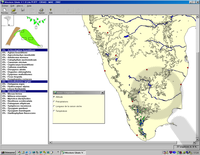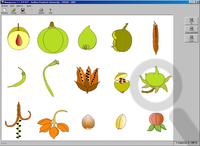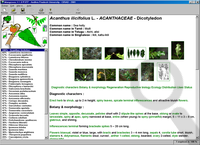In order to minimize and resolve these constraints, the identification
system uses a graphical system which reconstitutes the plants using images.
This method has several advantages:
- It only uses drawings instead of technical jargon.
- It provides users the freedom to choose the character that needs to
be described.
- Missing information or data are permitted, thus allowing for the
identification of incomplete samples.
- Certain level of observational errors are also tolerated.
- At each step of the identification process, a probability of resemblance is calculated for each species.
- Thus species are sorted by decreasing order of similarity.
- At each step and moment, users could access the photos, the description, and the botanical illustrations of the species.
- In case users encounter doubt in the choice of characters (for description), they could ask the program for the most pertinent one.
- If the probability of a species identified is less than 100 percent, the program indicates the characters that contain bad description.
- Descriptions of the species can be available through Internet Website with any type of browser.
- The program being multilingual, it caters to a larger section of people.
- All the technical terms used are highlighted and at a click, an hypertext illustrated definition is accessible.
- Distribution of the species with GIS capabilities
A tool for :
- Young scientist training and capacity building
- Species identification for biodiversity studies
- Information dissemination









